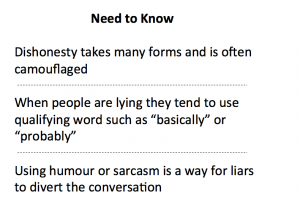The Best Ways to Spot a Liar
May 30, 2015 ~ Written by: W.B. “Bud” Kirchner
 “You can fool some of the people all of the time, and all of the people some of the time, but you can not fool all the people all the time.” – Abraham Lincoln
“You can fool some of the people all of the time, and all of the people some of the time, but you can not fool all the people all the time.” – Abraham Lincoln
In the previous article – “How do You Know Who You Can Trust?” – I focused on some caveats related to detecting lies and misinformation and reviewed some details on nonverbal signals.
Now – I would like to take a look at verbal signals as well as a couple examples of how lies of various shapes and sizes manifest themselves.
How Liars Talk
 As a supplement to the previous articles and the above summary – I have pulled together a short list of verbal cues.
As a supplement to the previous articles and the above summary – I have pulled together a short list of verbal cues.
As usual, I am starting with a vast amount of information (including some conflicting) with an objective of sharing something I can stand behind. So – based on past practice I will focus on things I have seen work.
In no particular order, because regardless of size or shape, lies are lies:
- Appeal to deities: “God knows I am telling the truth.”
- Qualifying words: “Basically.” “Probably.”
- Unnecessary details: Try to be more convincing and imply not making it up.
- Humor/sarcasm: Divert the discussion.
- Parroting: Repeating questioning words in answer, i.e. “Did you take the money?” “No – I did not take that money.”
- Story inconsistencies: Sometimes the (inexperienced) liar confuses themselves.
- Vocalization: Shallow/cracked voice. Changed tone/cadence.
- Speak of selves in third party: Obvious disassociation.
- Frequent speech emotes: “Um” and “uh” etc.
Is it Dishonesty or Strategy?
“A lie that is half-truth is the darkest of all lies. – Lord Alfred Tennyson
I am presenting the following mindful they sit at a fine line between dishonesty and ‘strategy’ but I include them since I think they illustrate how fair and efficient business is dependent on honesty at all points. In this case the situations range from about $1M to over fifty times that amount.
- Startups represent a unique context for several reasons. You could argue that if everyone involved did not have distorted reality they would not accept the risks that are inherent in startups. In fact, I have heard people say the ability to lie is paramount with a startup CEO.
At the exaggerated risk of splitting hairs – we love optimism but we don’t appreciate falsified lab results, client expressions of interest, etc. Sadly, startups (management and investors) initially distort the truth out of enthusiasm and subsequently out of desperation.
Ironically, if they are successful in misleading others (presumably to raise more investments) the most likely outcome is poor capital efficiency which comes back to bite them as they are diluted. Is it possible honesty really is the best policy?
“Lying is the greatest of all sins.” ~ Alfred Nobel
The next two examples involve the same misleading approach. Basically, the concept is that one enters into an agreement/makes an offer knowing full well that just before the transaction closes you will balk and have significant leverage with the other party since they have so much ‘sunk’ time and costs.
How does this manifest itself? Here are a few situations:
- We were one of three groups bidding on a portfolio of companies. Abruptly, we were informed it was now a two horse race. When the sellers did due diligence on the three groups, they discovered one of the groups had developed a reputation for ‘retrading’ at the 11th Regardless of where the final bids would land, the seller had decided they would take their chances on value rather than do business with a group that “could not be trusted.”
- In our advisory business, we spent a considerable amount of time structuring a joint venture and subsequently marketing the services. As we were about to start our first (major) engagement our partner decided they wanted to retrade. Our options were to bend over or suffer the embarrassment with our client and the financial setback per the retrade. Our decision was simple – we would not bend over. We would (and will) endure any financial and reputational hit rather than pursue a partnership with dishonest people.
The moral of these stories is that dishonesty takes many forms and is often camouflaged. For reasons I’ve described in this article you can never let your guard down. I hope some of what I have shared with you helps you in this regard.
You Can Never Know Too Much
One conclusion I would like to propose here is based on the scope for dishonesty, the context for rewards and the difficulty in detecting lies as we have illustrated in these two articles.
I would suggest this highlights the importance of another topic from past articles – due diligence. You can never know too much about the people you are doing business with. I think it is an important skill to be able to determine if more due diligence, reference checks, etc. are called for. But – the real focus should reflect the following:
We have seen ample evidence that past behavior is arguably the best prediction of future behavior.
“Always tell the truth. Even if you have to make it up.” – Author Unknown
References
In case you want to dig deeper:
- “Spy the Lie: Former CIA Officers Teach You How to Detect Deception” – Philip Houston Michael Floyd and Susan Carnicero
- “Lie Detection: Develop An Eye to Spot A Liar & Never Be Deceived Again!!!” – Aiden McCoy
- “Human Lie Detection and Body Language 101: Your Guide to Reading People’s Nonverbal Behavior” – Vanessa Van Edwards
For my closing comment on the situation, I turn to an author, American economist and political philosopher:
“There are only two ways of telling the complete truth – anonymously and posthumously.” – Thomas Sowell
About the Author: W.B. “Bud” Kirchner is a serial entrepreneur and philanthropist with more than 50 years of business success. He is not a scientist or an academic but he does have a diversified exposure to neuroscience, psychology and related cognitive sciences. Generally speaking, the ideas he expresses here are business-angled expansions of other people’s ideas, so when possible, he will link to the original reference.
